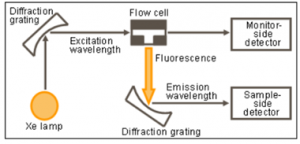HPLC Fluorescence Detector
A fluorescence detector (FLD) is a device commonly used in chromatography, particularly in techniques like high-performance liquid chromatography (HPLC). It operates based on the principle of measuring the fluorescence emitted by certain compounds when they are exposed to excitation light (Xenon lamp). Below you can find a more in-depth explanation on how FLD works and a schematic drawing to understand the principle better (Figure 1).

Figure 1. Schematic drawing of the FLD
The detector starts with an excitation light source, often a high-energy light source such as a xenon lamp. This light emits a light beam at a specific wavelength, known as the excitation wavelength. The chosen wavelength depends on the specific absorbance properties of the compounds of interest. The sample, which contains analytes with fluorescent properties, is introduced into the detectors’ flow cell. As the sample flows through the cell, it encounters the excitation light. Compounds in the sample that have inherent fluorescence, known as fluorophores, absorb the energy from the excitation light at the excitation wavelength. This absorption elevates the electrons in the fluorophores to a higher energy state.
After absorbing energy, the excited electrons return to their lower energy state, releasing the excess energy as fluorescence. This emitted light occurs at a longer wavelength than the excitation light and is characteristic of the specific fluorophores present in the sample. A detector, typically equipped with a photomultiplier tube (PMT) or a photodiode array, captures and measures the intensity of the emitted fluorescence. The detector is set to emission wavelength, allowing selective detection of the fluorescent signal. The detected fluorescence signal is converted into an electrical signal, processed, and recorded as a chromatogram. The chromatogram represents the intensity of fluorescence, relative to compound concentration, at different wavelengths as the sample components elute from the chromatographic column.
In summary, a fluorescence detector works by exposing a sample to an excitation light source, causing fluorescent compounds in the sample to absorb energy and emit fluorescence, under particular wavelengths. The emitted fluorescence is then detected and measured, providing information about the presence and concentration of specific analytes. Fluorescence detectors are particularly useful for compounds with natural fluorescence or those that have been labeled with fluorescent tags for detection (derivatization).
Consumables and Spares:
- SCION 6440 FL Detector
- Peek Tubing (LC21000001)
- Xenon Lamp (LC20210147)
- HG Lamp (LC20210149)
- Flow cell (LC20200040)
Order Today
For more information or to place an order, please get in touch.
